
Which daffodil or narcissus to choose?
Our tips to plant the right variety
Contents
With their stunning yellow or white spring flowering, daffodils symbolise the end of the bad season and the arrival of spring! They are very easy to grow bulbous perennial plants. They have been extensively hybridised, and today there are thousands of varieties, from the largest to the smallest, from early to late bloomers, and from the most fragrant to those suited for forcing… Discover how to make the right choice to find the variety that matches your desires and situation!
Depending on the time of flowering
Don’t hesitate to plant together varieties that flower at different times, as this will allow you to enjoy them for much longer!
-
For early flowering
Daffodils signal the arrival of spring with their bright flowering! The ‘February Gold’ daffodil is one of the first to bloom. It brightens the garden with its vivid yellow flowers, sometimes as early as February! As for the ‘Tête à Tête’ daffodil, it offers yellow flowers from March. If you’re looking for a miniature variety, for example to grow in a pot, choose the ‘Jet Fire’ daffodil, with yellow flowers. You can also opt for tazetta daffodils, which bear clustered and fragrant flowers at the end of winter. Narcissus cyclamineus ‘Trena’ offers a bicolour flowering, white and yellow, in February or March. For something more original, choose Narcissus bulbocodium ‘Cantabricus’, with bell-shaped white flowers!
The earliest varieties need to be planted early in autumn, ideally in September. Later planting would delay flowering. Don’t hesitate to consult our advice sheet – How to plant early daffodils

Narcissus cyclamineus ‘Trena’, Narcissus ‘Tête à Tête’ and Narcissus bulbocodium ‘Cantabricus’ (photo Nzfauna)
-
For late flowering, just before summer!
Some varieties wait until the end of spring to reveal their flowering! This is the case for the stunning Poet’s daffodil, Narcissus poeticus, which blooms around May. You can also choose the ‘Avalanche’ daffodil, which bears small clustered flowers, yellow and white. For a pure white flowering, very elegant, we recommend Narcissus triandrus ‘Petrel’. As for the ‘Rose of May’ daffodil, it offers a truly different flowering from other daffodils, with superb double, cream-white flowers that are fragrant. If you choose these late varieties, we recommend watering in case of particularly dry spring weather.
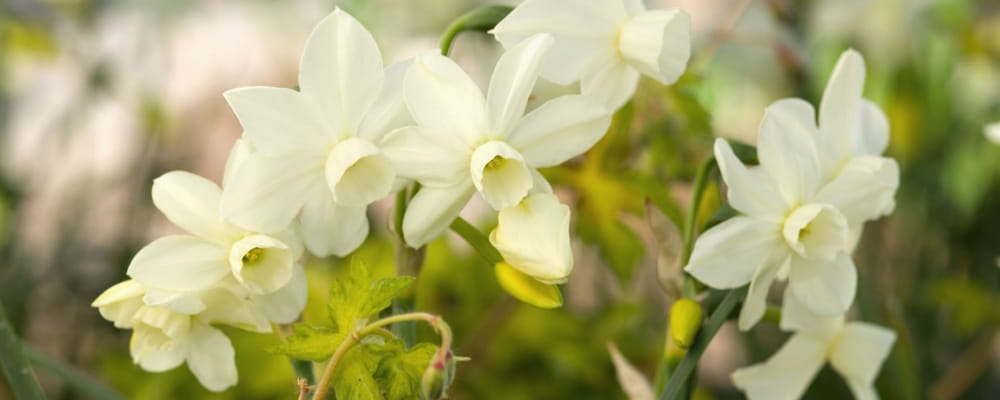
Narcissus triandrus ‘Petrel’ offers an elegant white flowering (photo iBulb – Rob Cardillo)
Read also
Plant early daffodilsAccording to the height
-
The Tallest
The tallest varieties create an impressive effect in a border, when combined with other bulbous plants like tulips or fritillaries. Narcissus ‘Acropolis’ is one of the tallest, reaching up to 50 centimetres! It offers unique, double flowers, white with orange shading in the centre. More common, yet still remarkable, the daffodil ‘Dutch Master’ has bright yellow flowers very similar to those of the wild jonquil. Also discover the variety ‘Mount Hood’, which bears large white flowers.
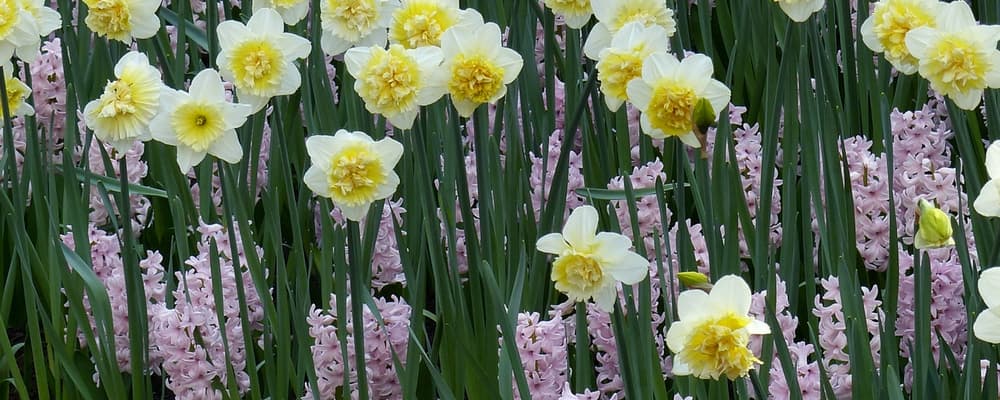
The tallest daffodils are suitable for planting in borders. Here, Narcissus ‘Ice King’ and hyacinths ‘Fondant’
-
The Smallest Varieties
The shortest daffodils are suitable for planting in rockeries or pots. This is the case for many botanical daffodils, which are appreciated for their understated and delicate, almost touching appearance. This includes varieties from Narcissus cyclamineus, early-flowering daffodils that often measure between 15 and 20 cm. For example, you can choose the variety ‘Tête à Tête’ (15 cm tall), with yellow flowers. Also discover Narcissus tazetta ‘Minnow’: a superb miniature daffodil that does not exceed 20 cm in height! For particularly unique flowering, opt for the small Narcissus bulbocodium ‘Cantabricus’, with bell-shaped white flowers.
Discover our entire range of mini-daffodils.
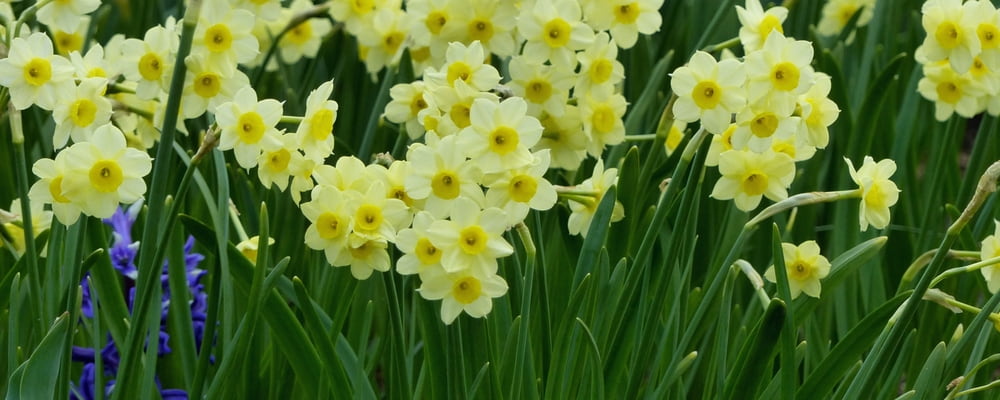
Narcissus tazetta ‘Minnow’
Discover other Narcissi - Daffodils
View all →Available in 1 sizes
Available in 1 sizes
Available in 1 sizes
Available in 1 sizes
Available in 1 sizes
Available in 1 sizes
Available in 1 sizes
Available in 1 sizes
Available in 1 sizes
Available in 1 sizes
For a natural style
Narcissi are appreciated for their natural and simple charm; they remind us of walks in nature, where we marvelled at these bright flowerings. Choose from single-flowered narcissi and botanical narcissi, which easily naturalise. For a very elegant and light flowering, we recommend the poet’s narcissus, Narcissus poeticus ‘Recurvus’. If you desire yellow flowers, look towards the wood daffodil, Narcissus pseudonarcissus. For something more original, be surprised by the bell-shaped flowers of Narcissus bulbocodium. You can also fall for the small clustered flowers, yellow and white, of the variety ‘Avalanche’! Scatter your narcissi at the foot of deciduous trees, alongside Fritillaria meleagris, Crocus, or Muscaris.
→ To discover: 5 varieties of white-flowered narcissi
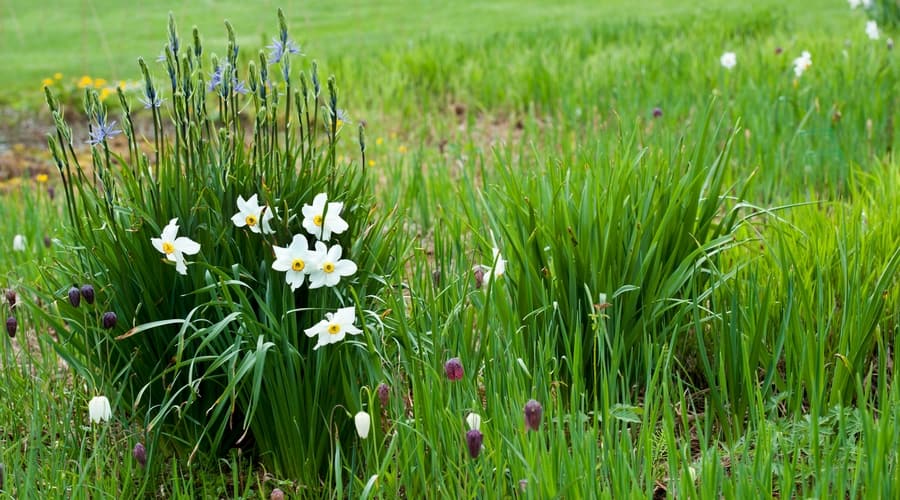
The Poet’s Narcissus fits perfectly into a natural scene. Here, Narcissus poeticus ‘Actaea’ with Fritillaria meleagris and Camassia leichtlinii ‘Caerulea’ (photo iBulb)
For a sophisticated look
With several thousand varieties, daffodils offer true diversity in terms of shapes: some have astonishing, even extravagant, flowerings! Discover the many varieties with double flowers or orchid-like flowers. In addition to surprising us, they are perfect for creating bouquets! We recommend the variety ‘Acropolis’, with its large double flowers, reaching about ten centimetres in diameter, white with an orange heart. As for daffodil ‘Trepolo’, it offers an original white flowering, with an open and split crown at the centre, marked with orange. For a yellow flowering, be surprised by Narcissus ‘Rip Van Winkle’ and its tousled flowers, with numerous fine petals going in all directions! Finally, discover daffodil ‘Petit Four’ which offers a cream-white and orange flowering, with a frizzled central crown.
→ Find our article on the best orchid-like daffodils to brighten up your garden.

Narcissus ‘Trepolo’, Narcissus ‘Rip Van Winkle’ and Narcissus ‘Petit Four’
The scented ones
Enjoy the highly fragrant flowerings of certain varieties! We recommend planting them in groups, near your home or a thoroughfare, along pathways. You can choose Narcissus ‘Fragrant Rose’ for its pleasant rose scent, or the Poet’s Daffodils (Narcissus poeticus) which, in addition to offering an elegant flowering, are very fragrant! Also discover the yellow and white flowering of the daffodil ‘Geranium’! Among the Narcissus tazetta, a group of fairly fragrant daffodils, the variety ‘Avalanche’ is noteworthy for its small white and soft yellow flowers. Explore our range of scented Daffodils!
Another way to enjoy their fragrance is to grow them in pots inside the house. In this case, you can opt for the white flowers of Narcissus ‘Paperwhite’ or the yellow flowering of Narcissus ‘Baby Moon’.
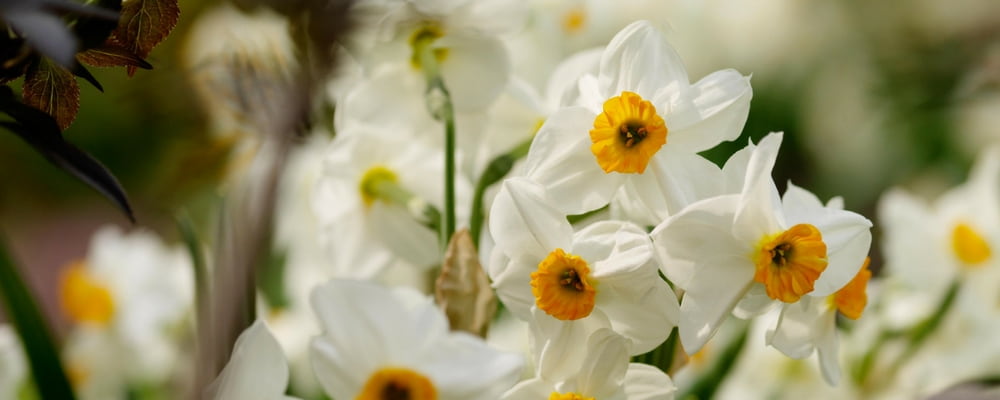
Narcissus ‘Geranium’ (photo iBulb – Steven Bemelman)
Multiflorous
Although some daffodils bear solitary flowers, others have flower spikes that group numerous flowers, resembling true bouquets! This is the case for the inflorescences of Narcissus tazetta, which can gather up to 15-20 small flowers! For instance, the daffodil ‘Grand Soleil d’Or’ features multiple small, brightly coloured flowers in yellow and orange. Also, discover the highly fragrant flowers of the daffodil ‘Geranium’, with white petals and an orange crown. For particularly delicate flowering, fall for the small yellow and white flowers of the daffodil ‘Avalanche’!
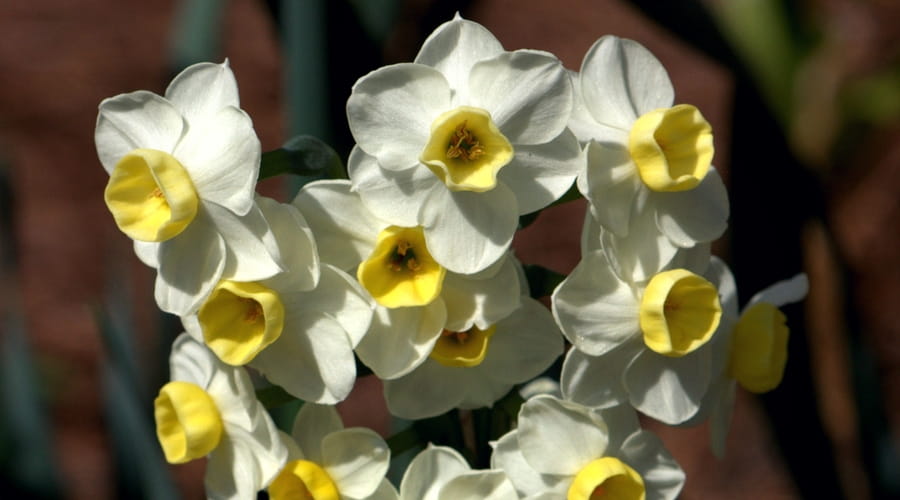
The daffodil ‘Avalanche’ (photo Magnus Manske)
To grow in a pot
-
Forcing to have flowers in winter!
It is possible to force daffodil bulbs to enjoy an early flowering. Thus, some varieties will allow you to have flowers at Christmas! We recommend choosing bulbs of a large size, as they have more reserves and will better withstand forcing. The variety ‘Paperwhite Totus Albus’ is the most suitable! It will charm you with its lovely pure white flowers. For a bicolour flowering, opt for the variety ‘Minnow’. You can also enjoy the yellow flowering of the daffodil ‘Tête à Tête’, or the large white flowers of the daffodil ‘Mount Hood’.

The daffodil ‘Paperwhite’ is an ideal variety for forcing
-
In pots outdoors
Daffodils are perfect for flowering a terrace or a windowsill! Choose the smaller varieties (up to 20-25 centimetres in height), and reserve the larger ones for growing in the ground. Again, we recommend Narcissus ‘Tête à Tête’. It is a very versatile mini-daffodil, which sometimes offers a lovely yellow flowering as early as March. Also discover the small bicolour flowers of Narcissus tazetta ‘Minnow’.
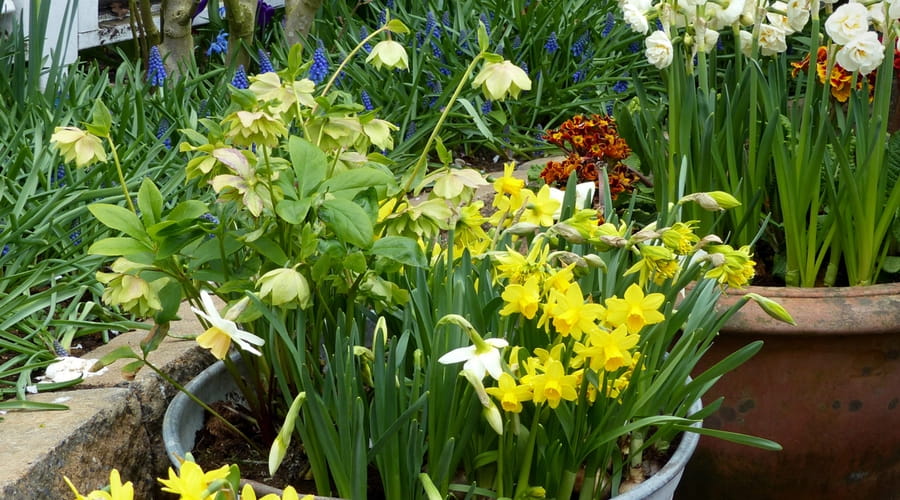
The daffodil ‘Tête à Tête’, in a pot with hellebores.
To naturalise!
Make the most of daffodils to brighten up a part of the garden where you do little maintenance, allowing it to remain quite wild. You can plant the bulbs in a short grass meadow or, ideally, at the base of deciduous trees. Narcissus ‘Obvallaris’ is one of the best varieties for naturalising! It is very similar to the wood daffodil, which can be found growing wild in nature. It will easily establish itself in your garden and will return faithfully, year after year. Also discover the particularly elegant and light white flowers with yellow centres of the Poet’s Daffodil, Narcissus poeticus.
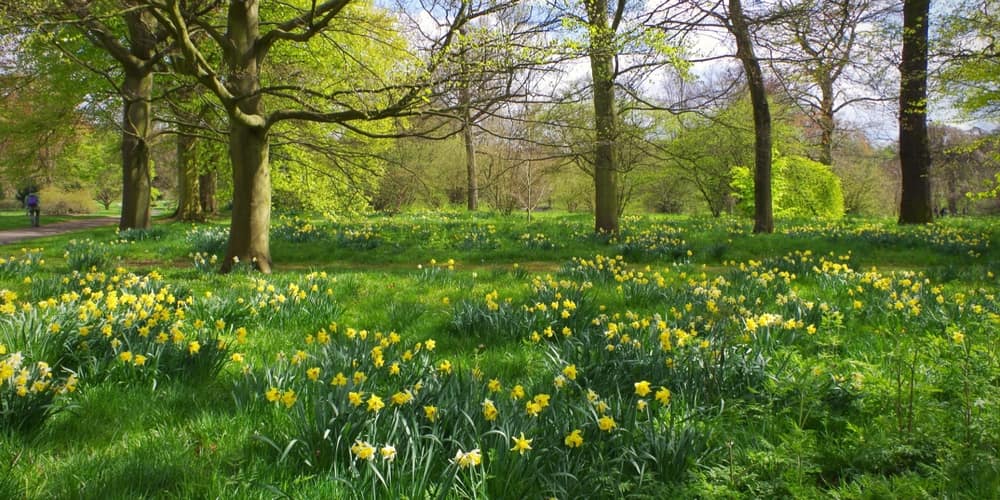 Feel free to let your daffodils naturalise
Feel free to let your daffodils naturalise
- Subscribe!
- Contents































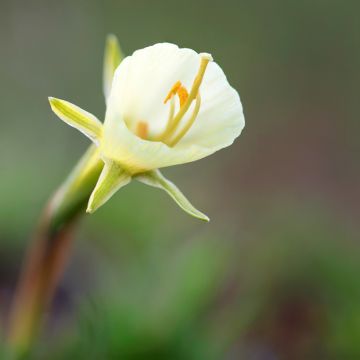
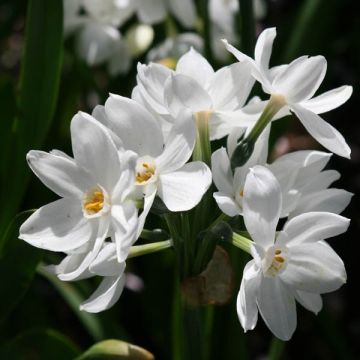
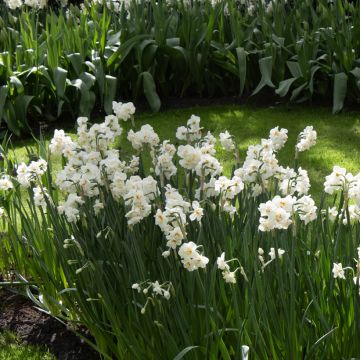
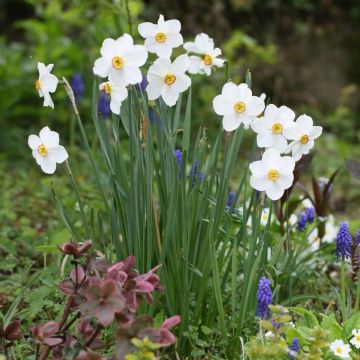
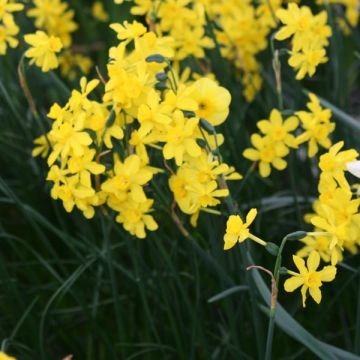


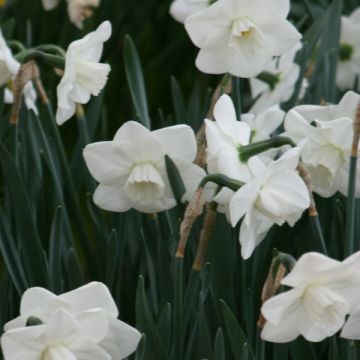


Comments